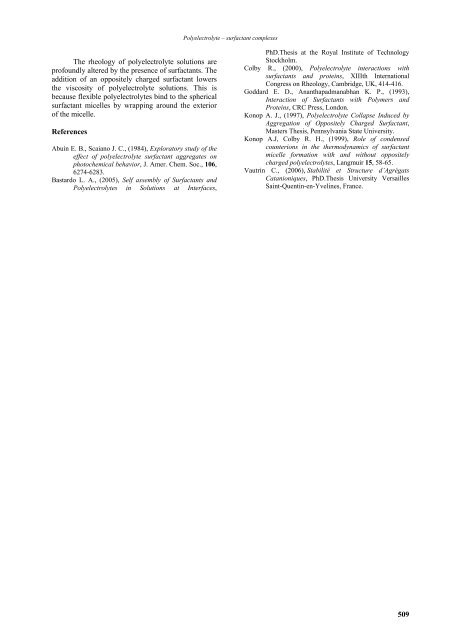2007_6_Nr6_EEMJ
Create successful ePaper yourself
Turn your PDF publications into a flip-book with our unique Google optimized e-Paper software.
Polyelectrolyte – surfactant complexes<br />
The rheology of polyelectrolyte solutions are<br />
profoundly altered by the presence of surfactants. The<br />
addition of an oppositely charged surfactant lowers<br />
the viscosity of polyelectrolyte solutions. This is<br />
because flexible polyelectrolytes bind to the spherical<br />
surfactant micelles by wrapping around the exterior<br />
of the micelle.<br />
References<br />
Abuin E. B., Scaiano J. C., (1984), Exploratory study of the<br />
effect of polyelectrolyte surfactant aggregates on<br />
photochemical behavior, J. Amer. Chem. Soc., 106,<br />
6274-6283.<br />
Bastardo L. A., (2005), Self assembly of Surfactants and<br />
Polyelectrolytes in Solutions at Interfaces,<br />
PhD.Thesis at the Royal Institute of Technology<br />
Stockholm.<br />
Colby R., (2000), Polyelectrolyte interactions with<br />
surfactants and proteins, XIIIth International<br />
Congress on Rheology, Cambridge, UK, 414-416.<br />
Goddard E. D., Ananthapadmanabhan K. P., (1993),<br />
Interaction of Surfactants with Polymers and<br />
Proteins, CRC Press, London.<br />
Konop A. J., (1997), Polyelectrolyte Collapse Induced by<br />
Aggregation of Oppositely Charged Surfactant,<br />
Masters Thesis, Pennsylvania State University.<br />
Konop A.J, Colby R. H., (1999), Role of condensed<br />
counterions in the thermodynamics of surfactant<br />
micelle formation with and without oppositely<br />
charged polyelectrolytes, Langmuir 15, 58-65.<br />
Vautrin C., (2006), Stabilité et Structure d’Agrégats<br />
Catanioniques, PhD.Thesis University Versailles<br />
Saint-Quentin-en-Yvelines, France.<br />
509


